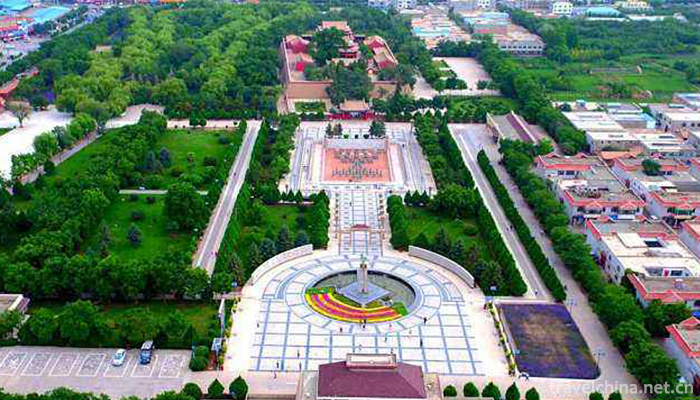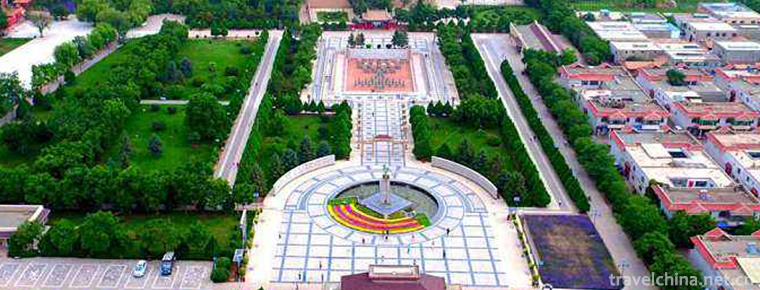Leitaihan Culture Museum Wuwei
Leitaihan Culture Museum, Wuwei
Leitaihan Culture Museum is located in the urban area of Wuwei City. It is the land of the Chinese tourism symbol "Ma Ta Feiyan". Leitai was declared as the key cultural relics protection unit in Gansu Province in 1983; Leitai Han Tomb was declared as the fifth batch of key cultural relics protection units in China by the State Council on June 25, 2001; passed ISO international quality system certification in December 2003; was designated as the third batch of provincial "patriotic education bases" in Gansu Province in April 2004; was awarded the National Youth Civilization number in June 2005; and national tourism in December 2005. It has been approved as a national AAAA-level tourist attraction. In 2012, it was designated as the national science popularization base by the National Association of Science and Technology.
Leitaihan Culture Museum is located in the urban area of Wuwei City. It is the land of the Chinese tourism symbol "Ma Ta Feiyan". Leitai was declared as the key cultural relics protection unit in Gansu Province in 1983; Leitai Han Tomb was declared as the fifth batch of key cultural relics protection units in China by the State Council on June 25, 2001; passed ISO international quality system certification in December 2003; was designated as the third batch of provincial "patriotic education bases" in Gansu Province in April 2004; was awarded the National Youth Civilization number in June 2005; and national tourism in December 2005. It has been approved as a national AAAA-level tourist attraction. In 2012, it was designated as the national science popularization base by the National Association of Science and Technology.
According to historical records, Leitai was built by King Zhang Mao of Qianliang (301 - 375, 1628 AD). "Ziye Tongjian" records: for the Eastern Jin Dynasty Yuan Emperor Daxing four years (AD 321) began to build "Zhou Lun more than 80 blockages, base high 9. Now the Leitai is well preserved, 106 meters long, 60 meters wide and 8.5 meters high. There are 10 ancient buildings in Ming and Qing Dynasties, such as Leizu Hall and Samsung Doumu Hall. Their buildings are magnificent and large-scale. Around the ancient trees towering, the lake ripples, is a well-known tourist attraction.
In September 1969, a late Eastern Han Dynasty (231 precious cultural relics and 30,000 ancient coins unearthed from 186 to 219 AD over 1800 years ago) was discovered in the southeastern corner of Taixia. It is called a rich "underground museum" by the historians. Among the unearthed cultural relics, the most prominent are the exquisite cast of 99 bronze chariot and horse terracotta warriors and a bronze galloping horse with the highest artistic value. In September 1971, Guo Moruo, a well-known archaeologist and vice chairman of the Standing Committee of the National People's Congress, discovered a copper galloping horse during a visit to the Gansu Museum, which was called "Ma Ta Feiyan". From April 1973 to August 1975, Tong Pengma, as an outstanding representative of Chinese archaeological culture, was exhibited in 14 countries and regions, causing great sensation and high praise.
In October 1983, "Ma Ta Feiyan" was designated as China's tourism symbol by the State Tourism Administration; in 1996, it was designated as a national treasure cultural relic. In 2009, the Leitaihan Cultural Museum combined with the free opening, carried out a series of exhibitions to improve the integration of knowledge, interesting and interactive, formed a Leitaihan cultural characteristics of "Tianma Xilai-Leitaihan Cultural Display", the audience is increasing rapidly, and achieved good social benefits. We warmly welcome Chinese and foreign tourists to China's tourist capital and witness the magical "horse stepping on a swallow" coming out of the land and the masterpiece of ancient people's wisdom.


-
1.Qingshui rock
National AAAA tourist attractions, built in the Northern Song Dynasty, were rebuilt in the Ming Dynasty. In the Northern Song Dynasty, the priest Puzu Zen Buddhist monk once practiced here
Time 2019-02-07 -
2.Legend of Boya Period
"When the evidence of the legendary place of Bo Yazi Period was found in Hanyang, I knew that it was hopeful to apply for the national level!" Yesterday, the reporter learned from the Provin
Time 2019-04-04 -
3.Silkworm custom
Haining City, the ancient name is meaningful, and later because of drunken plum from wood changed its name to salted plum. This is the seat of Changshui County in the Spring
Time 2019-04-04 -
4.Traditional pasta making techniques
Traditional pasta making technology was listed in the second batch of national intangible cultural heritage list in 2008.
Time 2019-04-20 -
5.Dai opera
Dai Opera, one of the national intangible cultural heritage, is a traditional drama in Jingpo Autonomous Prefecture of Dai Nationality in Dehong, Yunnan Province.
Time 2019-04-23 -
6.Dragon boat Racing
Dragon boat racing is one of the customs of the Dragon Boat Festival in China, and it is also one of the most important festival folk activities of the Dragon Boat Festival. It is common in southern C
Time 2019-06-12 -
7.She Costume
She nationality's men and women's clothing is basically the same as that of the local Han people. However, the She ethnic costumes in Fujian and Zhejiang provinces with relatively concentrated populat
Time 2019-06-14 -
8.University of Electronic Science and Technology Of China
Located in Chengdu City, Sichuan Province, the University of Electronic Science and Technology, formerly known as the Chengdu Institute of Telecommunication Engineering, was deployed by Premier Zhou E
Time 2019-08-31 -
9.Modern cheongsam
At the beginning of the 20th century, it was popular to wear a short jacket with trumpet shaped wide sleeves inside, and a long waistcoat without sleeves with the front and back of the coat reaching the ground. Since then, cheongsam has made some changes in the edge, sleeve
Time 2020-12-11 -
10.History of Nanchong
In the Northern Song Dynasty (960-1127), there were three states in the territory, which governed 13 counties, such as Nanchong (prefecture), Xichong and Xiangru, which were subordinate to Chengdu Fulu.
Time 2020-12-17 -
11.Location of Meishan
Meishan is located in the southwest of Chengdu Plain and the middle reaches of Minjiang River in Sichuan Basin. It spans 29 ° 24 ′ - 30 ° 16 ′ N and 102 ° 49 ′ - 104 ° 30 ′ e. it is 150 km long from east to west and 72 km wide from south to north. It connects Chengdu,
Time 2020-12-18 -
12.Meishan science and technology
In 2019, 80 science and technology projects above the municipal level will be organized and implemented, and 27.73 million yuan of free science and technology project funds will be put in place. In the whole year, 433 patents were applied and 94 patents were
Time 2020-12-18